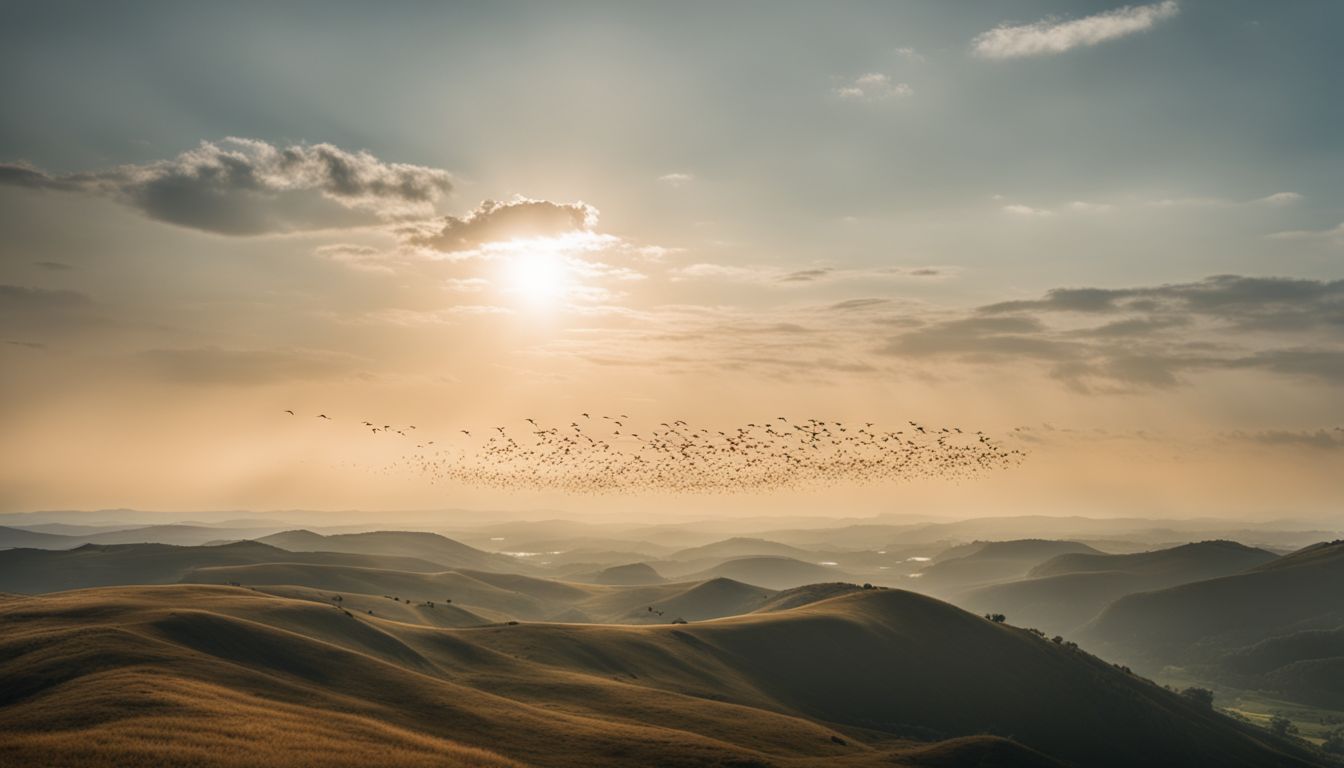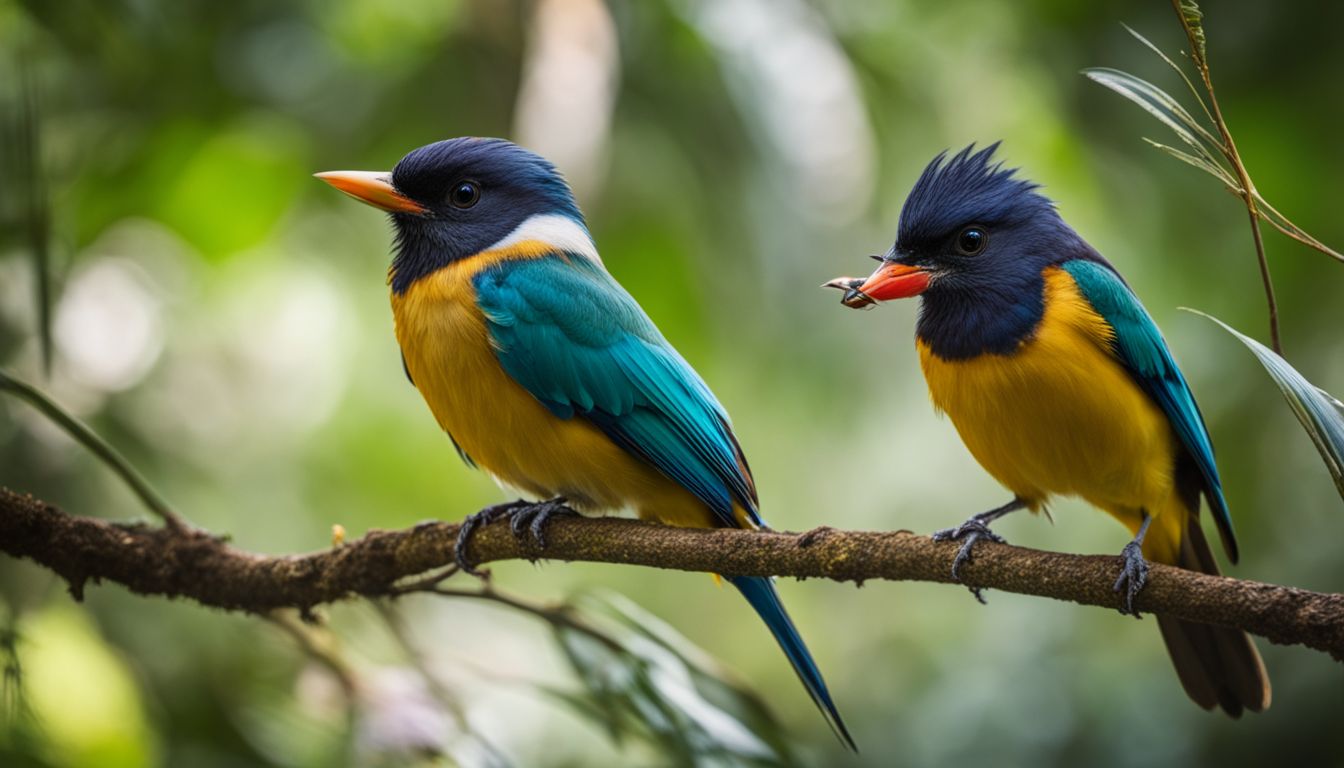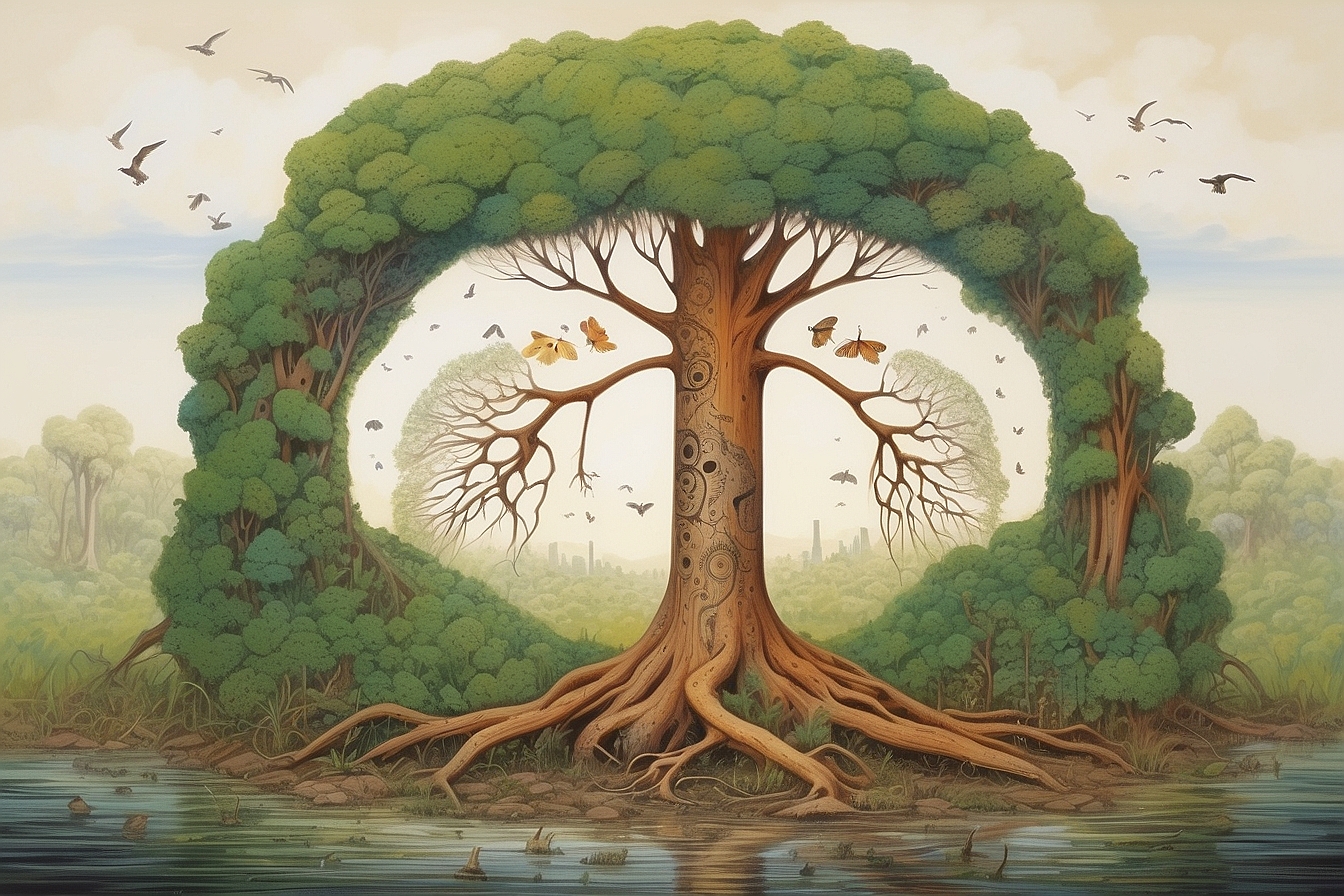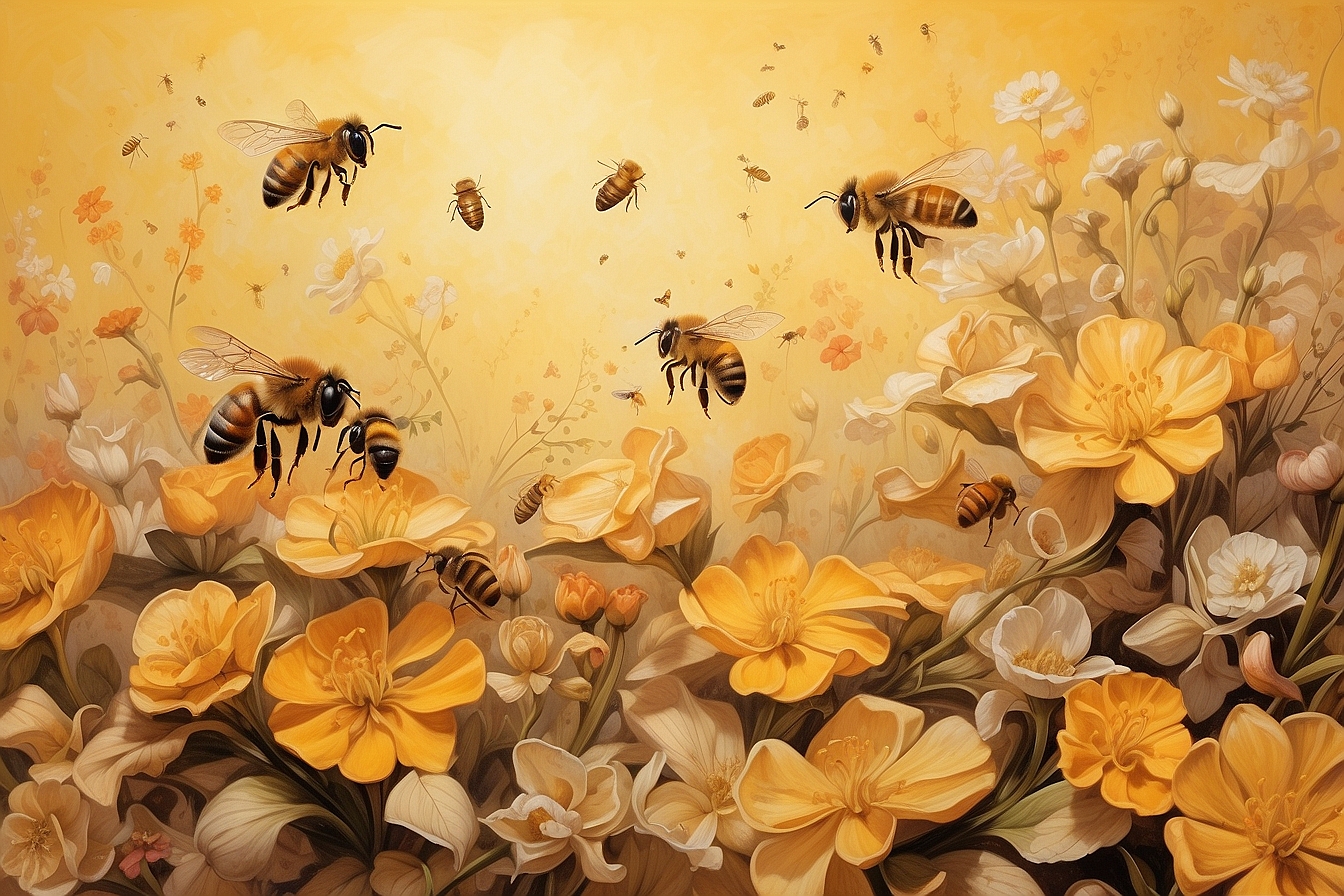Amidst the quiet of our local green spaces, one can’t help but feel a twinge of concern; the dulcet tones of birdsong are noticeably sparse. It’s something we’ve picked up on too and, spurred by this eerie stillness, we’ve thoroughly investigated just why these winged wonders are so imperative to our world’s tapestry.
Astonishingly, it transpires that a single bird species is capable of dispersing upwards of 30,000 seeds across the land in merely a day! Our forthcoming article explores this remarkable contribution and sheds light on how avian species are indispensable in maintaining biodiversity and ensuring robust ecosystem functionality.
Continue perusing – for the future vibrancy of our skies hangs in balance.
Key Takeaways
- Birds are essential for healthy ecosystems by acting as natural fertilisers, pest controllers, habitat creators, and sanitation workers.
- They indicate the overall health of an environment; any changes in bird populations signal shifts in biodiversity and ecosystem conditions.
- By dispersing seeds and pollinating plants, birds help maintain plant diversity which is crucial for robust wildlife habitats.
- Bird diversity directly impacts ecological balance; varied bird populations contribute to a stable environment with efficient nutrient cycling and pest regulation.
- Protecting bird habitats is critical not just for avian species but also for preserving global biodiversity and ensuring humans’ well-being.
The Significance of Birds in the Ecosystem

Birds play a vital role in maintaining ecological harmony, performing essential tasks that support the intricate web of life. Their daily activities nurture and shape our environment, ensuring its health for future generations.
Birds as Fertilisers
We often overlook how birds contribute to the health of our ecosystems, especially when it comes to soil fertility. Through their droppings, known as guano, they distribute vital nutrients across forests and fields.
This natural fertiliser boosts plant growth, which in turn supports a wider range of wildlife.
Guano is rich in nitrogen, phosphate and potassium – key ingredients for healthy vegetation. As avian species traverse different areas, they disperse these elements far and wide, aiding in the spread of various plants and contributing to species diversity.
Our feathered friends serve as essential players in maintaining the ecological balance necessary for a thriving environment. Their role ensures that forests remain robust health preservers within our planet’s delicate network of life.
Birds as Forest Health Preservers
Moving from the role of birds as natural fertilisers, we come to another crucial service they provide. Birds act as forest health preservers by controlling pests and thus maintaining the delicate balance of our woodland ecosystems.
They consume countless insects and small mammals that could otherwise cause significant damage to trees and plants.
Our feathered friends also play a part in preventing disease spread among plants. By eating infected specimens, they halt the proliferation of harmful pathogens. This activity supports not only tree health but also boosts overall forest resilience against environmental threats such as climate change and habitat destruction.
Birds as Eco-friendly Exterminators
We often overlook the incredible service birds provide in controlling pests. They swoop through fields and forests, devouring insects and rodents that can damage crops and spread disease.
Take the barn owl, for instance; it’s a natural predator of mice and voles, keeping their populations in check without the need for harmful pesticides. In gardens too, songbirds pick off aphids and caterpillars which could otherwise ruin plants.
By encouraging bird habitats on farms and in our backyards, we’re inviting these eco-friendly exterminators to work their magic. Installing nest boxes or planting native shrubs provides shelter for insect-eating species like swallows or blue tits.
We bolster biodiversity by welcoming them into our spaces while naturally maintaining pest control – a win-win situation for both us and the environment.
Birds as Habitat Creators
Birds play a pivotal role in shaping the landscapes we cherish. Their daily activities, from nest building to foraging, create microhabitats essential for other wildlife. Woodpeckers are particularly notable habitat creators; their search for insects leads them to carve out cavities in trees.
These hollowed spaces then become nesting sites for a host of species that would otherwise struggle to find a home.
Our feathered friends also aid in plant dispersal by carrying seeds over vast distances. This act ensures the propagation of countless plant species, contributing to diverse and thriving ecosystems.
Their droppings enrich the soil with nutrients, further assisting in the growth of vegetation which provides food and shelter across trophic levels — making birds indispensable architects of biodiversity wherever they roost or migrate through wetlands or forests.
Birds as Sanitation Workers
Transitioning from creating habitats, we also celebrate our feathered friends for keeping ecosystems tidy. Acting as natural custodians, birds like vultures and carrion crows play a critical role in waste management.
They feast on dead animals, preventing the spread of disease and turning potential health hazards into vital nutrients that enrich the soil.
These avian sanitation workers are essential to maintaining balance in nature. Their unique ability to recycle life back into the earth serves as an ecosystem service that often goes unnoticed yet is indispensable for environmental health.
By doing what comes naturally to them, scavengers help clear our skies and lands, contributing silently but effectively to conservation efforts worldwide.
Birds as Helpers to Other Species
We often marvel at the intricate ways birds support other life forms within their habitats. They play a crucial role in pollination, carrying pollen from one flower to another as they search for nectar.
This task boosts plant reproduction and enriches biodiversity, sustaining ecosystems where flowers and trees flourish. Birds like the greater honeyguides take this mutual relationship even further; they lead humans to bee hives, ensuring both species can enjoy the sweet rewards of honey.
Birds also assist in seed dispersal, dropping seeds over vast distances in their droppings. This spreads plant species across different areas, helping forests regenerate after land clearing or degradation.
Carrion birds contribute by consuming dead animals, which prevents the spread of disease and supports a healthy environment. By fulfilling these roles conscientiously, our feathered allies are true guardians of biological diversity, making every effort to protect it from decline and loss.
Birds and Biodiversity: Lifeline of the Earth

As we delve into the crucial role birds play within our planet’s ecosystems, it’s evident they’re more than mere participants; they are a lifeline, integral to Earth’s biodiversity.
Their presence and patterns paint a broader picture of ecological health that we cannot afford to ignore.
Birds as Indicators of Biodiversity
We often overlook how birds reflect the health of our environment. Their presence or absence tells us a lot about biodiversity around us. Birds play a crucial role as ecological indicators because they are sensitive to changes in habitats and climate.
When we notice shifts in bird populations, it’s likely that other parts of the ecosystem are affected too.
By keeping an eye on bird species richness and patterns, we get insights into larger environmental trends. For instance, if migratory birds start skipping certain areas or resident species decline, this could signal habitat loss or degradation.
Protecting these feathered friends is essential for maintaining nature’s balance and preserving diverse life forms found nowhere else on Earth.
Impact of Bird Diversity on Ecosystem Balance
Continuing from the role of birds as indicators of biodiversity, let’s delve into how varied bird populations contribute to the stability and health of our ecosystems. A tapestry of bird species weaves together a resilient environment where each avian member plays a critical part.
Birds help in controlling pests by eating vast quantities of insects, thus serving as eco-friendly exterminators and keeping crop damages at bay.
These feathered inhabitants also act as natural fertilisers; their droppings spread seeds and nutrients that lead to thriving plant communities. This planting labor isn’t trivial—it’s essential for generating natural environments that sustain a multitude of life forms.
Our actions can either support or disrupt this delicate balance, making environmental protection an undeniable priority for safeguarding the diversity that keeps our ecosystems functioning properly.
Relationship between Bird Diversity and Vegetation Habitats
In exploring the intricate dance of life, we uncover how bird diversity is deeply intertwined with the lushness of vegetation habitats. This symbiosis shapes the very fabric of our natural world, driving the health and vigour of ecosystems worldwide.
Role of Abundance and Diversity of Trees
Trees serve as vital habitats for countless bird species. Their leaves, branches, and trunks offer shelter and nesting sites while their fruits, nuts, and insects provide essential food sources.
We see forests teeming with life often mirror a mosaic of tree varieties; each unique in form and function. These varied structures cater to different avian needs – some birds thrive high in the canopy while others prefer the understory or forest floor.
As we foster diverse woodland environments, we contribute to stabilising local ecosystems. Trees are not just standing pillars but dynamic ecological engines driving biodiversity. They shape climate patterns which affect bird distribution and behaviours.
By protecting wide-ranging assortments of trees, we safeguard our feathered friends who depend on them for survival. Our commitment to these vibrant landscapes sparks a chain reaction – the more diversified our woods become, the richer our world grows in melody and colour from thriving avian populations.
Impact of Bird Species Richness, Abundance, and Shannon Diversity
We witness the vibrant tapestry of bird species richness in our woodlands and meadows, each bird adding a unique thread to the ecological fabric. This richness isn’t just about numbers; it’s also about variety.
Diverse bird communities contribute significantly to ecosystem services such as seed dispersal and pest control. They play pivotal roles, with each species performing specific tasks that help maintain the natural balance.
Abundance counts too; higher numbers of birds mean more eyes to spot prey and more wings to pollinate plants. The Shannon Diversity Index gives us a way to measure this diversity, taking into account both the number of species present (richness) and their relative abundance within an area.
As we strive for nature conservation, understanding these aspects helps us gauge how well different habitats support avian life, informing our efforts in protecting biodiversity effectively.
Birds and Human Well-being
Birds play an essential role in enhancing our quality of life, often without us even realising it. They support the balance of nature that maintains the spaces we live in and contribute to our mental and physical well-being through their presence and song.
Birds as Promoters of Biodiversity
We often overlook the crucial role our feathered friends play in maintaining the web of life. They scatter seeds across vast terrains, planting the future of forests and grasslands.
This natural process leads to a mosaic of habitats, where diverse plants flourish and numerous animal species find homes. As these birds traverse different ecosystems, their presence ensures that plant diversity is not just preserved but also nurtured.
By preying on insects, avian species control pests naturally and protect crops without resorting to harmful chemicals. This helps maintain a balance within ecosystems, allowing various forms of life to coexist harmoniously.
Our involvement in birdwatching fosters environmental awareness; it encourages us to safeguard the abundance and variety of birdlife – an act that inherently supports global biodiversity conservation efforts.
Birds as Indicators of Species Richness and Endemism
Bearing in mind the role of birds as promoters of biodiversity, it’s crucial to recognise their value in signalling species richness and endemism. Birds act like a living barometer, giving us a clear reading on the health of our natural environments.
They inhabit every climatic zone and adapt to a vast array of habitats, making them perfect indicators. When we see diverse bird populations thriving, it often means an area is rich in other life forms too.
Our feathered friends can also be endemic to certain regions—found nowhere else on Earth—which makes them key figures in understanding localised biodiversity crises caused by overexploitation or habitat loss from urbanisation.
Spotting these unique species helps conservationists pinpoint areas with urgent need for protection and serves as a call to action for preserving precious ecosystems before they’re irreversibly altered.
Changes in Bird Populations as Indicators
Bird populations act as early warning systems for changes in our environment. Like a natural barometer, shifts in their numbers can signal alterations in habitat quality, pollution levels or the impacts of climate change.
We observe these changes closely because they reflect broader ecological trends that could eventually touch us all.
We rely on birds not just for their beauty or songs but also to understand how our planet is faring. If we see certain species declining rapidly, it may point to over exploitation of resources or loss of biodiversity.
Conversely, an increase in bird diversity could indicate healthy ecosystems. These indicators are crucial for guiding conservation efforts and informing sustainable practices that will benefit both wildlife and humans alike.
Birds in Urban Mountain Parks
In urban mountain parks, the intricate lives of bird communities reveal much about the health of our treasured green spaces – join us to delve into their world and understand why it matters.
Distribution of Bird Communities in Different Habitats
Bird communities thrive in diverse habitats, each offering unique resources and challenges. Forests teem with songbirds that flit through the leafy canopy, while wetlands provide a feeding ground for waders and waterfowl.
Birds adapt to mountains’ harsh conditions by seeking shelter in rocky crevices or soaring high on thermal currents. Even deserts, often perceived as barren, support resilient species like sandgrouse that have mastered survival in such extreme environments.
Coastal areas see a mix of seabirds that swoop over waves or nest on cliffsides. Meanwhile, grasslands are home to ground-nesters who camouflage their broods among the tall reeds. Urban spaces attract adaptable birds capable of navigating human activity; here we find pigeons and sparrows exploiting our structures for their benefit.
These birds contribute significantly to biodiversity indicators across ecosystems by pollinating plants, dispersing seeds, and controlling pests—essential roles in maintaining ecological balance.
Response of Bird Communities to Vegetation Habitat Factors
We observe a fascinating dynamic between birds and their habitats. The vegetation around them plays a critical role in shaping the community. Diverse plant life encourages an array of bird species to thrive, each adapting uniquely to the surrounding flora.
As they interact with this environment, birds contribute to seed dispersal, aiding in the regeneration and spread of plant species.
Tall trees provide ideal nesting sites for many feathered creatures. Thick bushes offer shelter from predators and harsh weather conditions. Meanwhile, variations in the landscape influence how easy it is for birds to find food and mates.
It’s not just about survival; these interactions create a complex web that supports robust ecosystems where every element, including humans, benefits from nature’s harmony.
Temporal and Spatial Changes in Bird Diversity
Bird populations don’t remain static; they fluctuate through the seasons and over years. These changes reflect a complex tapestry of environmental factors at play. As birdwatchers, we see first-hand how urban growth, climate patterns, and habitat destruction shift the types of birds that thrive in certain areas.
Some species adapt well to these alterations, while others struggle or even disappear.
Tracking these temporal and spatial shifts gives us key insights into the health of our ecosystems. In urban mountain parks, for example, changes in bird diversity inform us about the quality of green spaces and their ability to support wildlife.
Our observations help direct conservation efforts where they’re most needed to maintain vibrant avian communities – essential for both nature’s balance and our own enjoyment as enthusiasts devoted to protecting biodiversity.
Implications for Urban Mountain Parks Management
Understanding the shifts in bird diversity over time guides us in managing urban mountain parks effectively. We see that diverse bird populations reflect healthy, functioning ecosystems.
Managing these parks therefore requires a focus on preserving habitats that support a wide range of avian species. By ensuring we have robust vegetation and undisturbed areas, we offer birds the spaces they need to thrive.
Our management strategies must also include monitoring bird numbers and their health regularly. This helps identify any negative trends or emerging problems quickly, enabling timely interventions.
As keen stewards of nature’s havens within our cities, we commit to safeguarding these green spaces for the winged wonders whose songs bring life to our urban mountainscapes.
Indicator Bird Species as a Baseline for Biodiversity
We look to indicator bird species as natural barometers of our environment’s health. These birds give us vital signals about the richness and variety of life in a given habitat. They act much like early warning systems, alerting us to changes and disturbances within ecosystems.
When certain bird populations fluctuate or decline, it raises a red flag that biodiversity may be at risk.
Our conservation efforts rely on these avian indicators to guide decisions and policies. We track their numbers and distribution, which provide essential data for managing wildlife habitats effectively.
By protecting these birds, we safeguard entire ecosystems, ensuring resilience against the looming biodiversity crisis. Let’s cherish every chirp and flutter as an invaluable piece in understanding the intricate matrix of life on our planet.
Conclusion
In conclusion, birds fill our world with more than just their melodies. They stand as crucial architects of ecological health and partners in sustaining life’s balance. As we’ve explored, their roles range from pest control to pollination.
Recognising the pivotal place they hold prompts us to safeguard their habitats fiercely. Our future flourishes when we honour and protect the symphony of birdlife thriving among us.
FAQs
1. What does biodiversity mean for birds?
Biodiversity refers to the variety of avian species and is essential for maintaining balanced ecosystems where birds thrive, influencing everything from pollination to seed dispersal.
2. How does bird song contribute to understanding biodiversity?
Birdsong acts as an indicator species’ signal, helping scientists track the health of environments and measure the impact of factors like urban green space on diversity.
3. Why are some types of birds, like ratites, important in nature?
Ratites play unique roles, such as scavenging which keeps habitats clean; these flightless birds also show how evolution shapes various species over time.
4. Can bird droppings actually benefit ecosystems?
Yes! Bird droppings act as natural fertilisers that enrich soils and help plants grow, indirectly supporting other forms of life including insects and fungus like truffles.
5. How do palaeontologists use the study of ancient birds related to dinosaurs?
Palaeontologists investigate evolutionary links between modern-day birds and dinosaurs through fossils which enhance our understanding of natural selection processes over millions of years.
6. What can citizens do to help support bird diversity?
Engagement in citizen science projects allows individuals to self-report bird sightings or participate in bio-pesticides application programmes—all contributing valuable data aiding conservation efforts.





